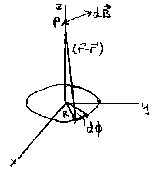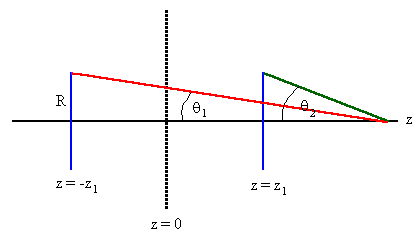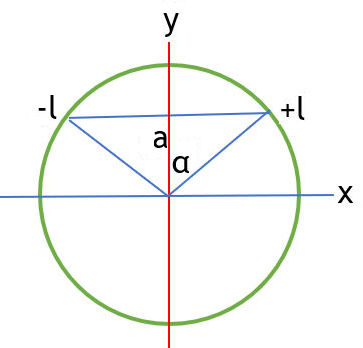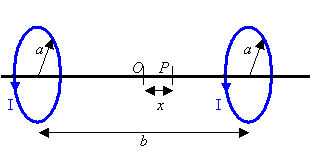The Biot-Savart law
Problem:
(a) A circular loop of wire of radius R carries a
current I. Find the magnetic induction B on the axis of the loop,
as a function of the distance z from the center of the loop.
(b) Use the result to find B at points on the axis of a solenoid
of radius R and length L wound with n turns per unit
length.
(c) Use this result to find the self-inductance of a very long solenoid (L >> R).
Solution:
- Concepts:
The Biot-Savart law, the principle of superposition, self inductance
- Reasoning:
We find the field of a single loop using the Biot-Savart law. The
principle of superposition then yields the field of many loops.
- Details of the calculation:

(a)
From the Biot-Savart law we have
dBz(r) = (μ0/(4π))[I dl'
x (r-r')/|r-r'|3]
∙ k.
On the z-axis r = zk.
Symmetry dictates that B = Bzk on the z-axis.
dl = Rdφ (φ/φ),
r -
r' = z k - R (ρ/ρ),
dl × (r -
r') = zRdφ (ρ/ρ) - R2dφ
k.
dBz = (μ0/(4π))[IR2dφ/(R2+z2)3/2].
Bz = ∫02πdBz = ½μ0IR2/(R2
+ z2)3/2.
At the center of the loop Bz = μ0I/(2R),
and for z >> R we have Bz = μ0IR2/(2z3).
For z >> R the field is proportional to 1/z3.
(b) Assume N loops are stacked up, from z' = -z1 to z' = z1, n per unit
length.
Bz = ½μ0IR2∫-z1z1ndz'/(R2
+ (z-z')2)3/2 = ½μ0IR2n∫z-z1z+z1dz''/(R2
+ z''2)3/2.
Bz = ½μ0IR2n{(z + z1)/[R2(R2
+ (z+z1)2)½] - (z - z1)/[R2(R2
+ (z-z1)2)½]}.

cosθ1 = (z + z1)/(R2
+ (z + z1)2)½, cosθ2
= (z - z1)/(R2 + (z - z1)2)½.
Bz = (μ0In/2)(cosθ1
- cosθ2)
For the solenoid n = N/L, z1 = L/2.
(c) At the center of the solenoid
B = Bzk.
Bz = (μ0In/2)(2z1/(R2
+ z12)½) = (μ0IN/2)((R2
+ (L/2)2)-½).
If L >> R then Bz ≈ (μ0In).
The field is approximately uniform inside the solenoid and approximately zero
outside the solenoid.
F = L1I, F = Flux, L1 = self inductance.
F = BπR2N = μ0InπR2N
= L1I, L1 = μ0n2πR2L
= μ0n2V, V = volume of
the solenoid.
Problem:
A circuit in the form of a regular polygon of n sides is circumscribed about
a circle of radius a.
(a) If it is carrying a current I, find the magnitude of the magnetic
field B at the center of the circle in terms of μ0, n, I, and a.
(b) Find B at the center of the circle as n is indefinitely increased.
Solution:
- Concepts:
The Biot-Savart law, the principle of superposition
- Reasoning:
We find the field of a single segment using the Biot-Savart law.
The principle of superposition then lets us add the fields of the
different segments.
- Details of the calculation:
(a)
The field B at the center of the circle due to the current in the
wire from -l to +l is
B(r) = (μ0/(4π))∫vI dl'
× (r-r')/|r-r'|3.
(SI units).

Here r = 0,
r' = xi + aj, dl'
= dxi, |r-r'| = (x2 + a2)½.
dl' × (r-r') = -(a dx) k.
B = -[μ0I/(4πa)]2l/(l2 + a2)½
k = -[μ0I/(2πa)]sin(α)
k.
For a regular plane polygon of n sides we have n wire segments.
Example: hexagon

For each segment 2α = 2π/n, α = π/n.
Symmetry dictates that
B(0) due to each segment is the same.
B(0) = -[nμ0I/(2πa)]sin(π/n)
k. B(0) = -[nμ0I/(2πa)]sin(π/n).
b) As n --> ∞, sin(π/n) --> π/n, B(0) --> nμ0I/(2πa)](π/n)
= μ0I/(2a).
This is the magnetic field at the center of a circular current loop of
radius a.
Similar problems
Problem:
Find the magnetic field at the center of a circular loop of
radius R that is formed in a long straight thin wire that carries current I; use
the SI system of units.

Solution:
- Concepts:
The magnetic field of a long straight wire and a current loop.
- Reasoning:
We use the principle of superposition.
- Details of the calculation:
B(r) = [μ0I/(2πR)][π + 1] out of the page
Problem:
In practical magnetic structures, uniform magnetic fields are frequently
necessary. The uniformity of the field produced by Helmholtz coils, or two
co-axial loops which carry currents in the same direction, is one of their most
important characteristics. Assume that the coils have a radius a, have
axes on the x-axis, carry current I each, and are separated by a distance b.

(a) Find the magnetic field at a point P on the axis of the loops and
a distance x from the midpoint O.
(b) Expand the expression for the field in a power series, retaining terms to
order x2.
(c) What relationship must exist between a and b such that the
x2 terms vanish? What is the significance of this?
(d) Show that the field created by the coils to this order and under the
conditions established in part c is given by Bx = 8I/(53/2aε0c2).
Solution:
- Concepts:
The Biot-Savart law, a series expansion
- Reasoning:
The magnetic field on the axis of a current loop is found from the
Biot-Savart law. Expanding the field near x = 0 in terms of x, we can
find the condition for the second order term to vanish. The first order
term is be zero due to the symmetry of the situation, so B(x) = B(0) to second
order if the
term proportional to x2 vanished.
- Details of the calculation:
(a) B = B(x)i on the x-axis.
B(x) = (μ0Ia2/2)[a2
+ (d-x)2]-3/2 + (μ0Ia2/2)[a2
+ (d+x)2]-3/2.
Here d = b/2.
(b) B(x) = B(0) + x(∂B/∂x)|0
+ (x2/2)(∂2B/∂x2)|0
+ ...
∂B/∂x =(μ0Ia2/2)[-(3/2)2(d+x)[a2
+ (d+x)2]-5/2 + (3/2)2(d-x)[a2 + (d-x)2]-5/2,
(∂B/∂x)|0 =
0.
∂2B/∂x2
= (3μ0Ia2/2)[5(d+x)2[a2
+ (d+x)2]-7/2 - [a2 + (d+x)2]-5/2
+ 5(d-x)2[a2 + (d-x)2]-7/2 - [a2
+( d-x)2]-5/2].
(∂2B/∂x2)|0
= (3μ0Ia2/2)[10d2[a2
+ d2]-7/2 - 2[a2 + d2]-5/2]
= (3μ0Ia2/2)[(8d2-2a2)[a2
+ d2]-7/2].
(c) For the second order term to vanish we need 8d2-2a2
= 0, d = a/2, b = a. The field is then uniform to second order.
(d) B(x) = B(0) = (μ0Ia2)[a2
+ d2]-3/2
= (μ0I/a)[1
+ ¼]-3/2 = (μ0I/a)(4/5)3/2
= 8I/(53/2aε0c2).
Problem:
An AC voltage source V(t) = V0sinωt is connected to a wire of
resistance R which forms a circular loop of radius a. The wire loop
rotates about the z-axis with angular frequency ω. Find the instantaneous
and the average magnetic field B (magnitude and direction) at the center
of the loop. Neglect the self-inductance of the loop.

Solution:
- Concepts:
The magnetic field at the center of a current loop
- Reasoning:
The magnetic field at the center of the loop has time varying x and y
components.
- Details of the calculation:
I(t) = V(t)/R = (V0/R)sinωt = I0sinωt.
B(t) = μ0I(t)/(2a) = μ0I0sinωt/(2a) = B0sinωt.
B0 = μ0V0/(2aR).
B(t) is the magnetic field at the center of the loop along the
n
direction.
B(t) = B0sinωt(cos(ωt)i + sin(ωt) j)
is the instantaneous magnetic field at the center of the loop expressed in
terms of its components along the axes of the coordinate system.
The average values of its components are
<Bx> = B0<sin(ωt) cos(ωt)> = 0,
<By> = B0<sin2(ωt)> = B0/2.
The average magnetic field is B = (B0/2)
j.






